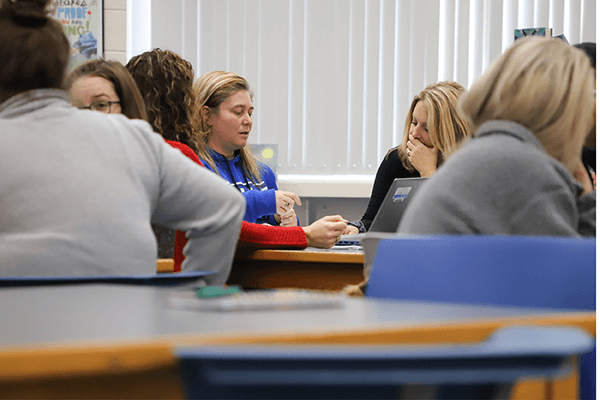While recent statistics from NAEP, also known as The Nation’s Report Card, show significant declines in math scores across the country, Johnston County Public Schools in North Carolina has something to celebrate.
Data released at the end of the 2021-22 school year showed the district increased math scores by double digits in grades 3-8, outperforming pre-COVID levels. These gains led the North Carolina Department of Public Instruction to single out Johnston County as the most improved school district in the state.
“Our teachers worked so very hard last year,” said Curriculum Director of K-12 Math and Science Leanne Daughtry. “And, in the end, there was a lot of impact on student achievement.”
The Need for a Change
Prior to the 2021-2022 school year, the district’s assessment data showed math scores were low, contributing to 14 out of 48 schools in the district being identified as low performing in 2019. Johnston County district leaders made it a priority to find out where they were going wrong. They started by taking a closer look at the math instruction across all the schools in the district. They soon realized that their strategy for letting teachers put together their own math instruction — pulling from a variety of different instructional sources and varying from classroom to classroom — was part of the problem.
“It didn't work for all students,” said Leanne. “I would say it worked really well for some students and for some teachers, but, when you look at our data, it wasn't serving all kids well.”
They realized they needed to make a change. The solution, they determined, was a cohesive core math curriculum that they could roll out districtwide, coupled with a well-planned strategy for implementation. After months of research and a successful pilot, they chose the enVision® series for grades K-12 to be that core mathematics curriculum because of the program’s rigor, digital learning components, and engaging lesson structure. Then, they designed a plan that would ensure every student in Johnston County Public Schools receives equitable access to this new high-quality instruction.
Step 1: Adopting a High-Quality Core Curriculum
 Adopting enVision was the first step in the plan to provide high-quality math instruction. Having a cohesive, districtwide core curriculum allowed educators to focus on teaching grade-level standards using a research-based lesson format. It gave them a common language and common pacing. It freed up valuable time for teachers, allowing them to spend less time planning and more time doing what they do best: teaching.
Adopting enVision was the first step in the plan to provide high-quality math instruction. Having a cohesive, districtwide core curriculum allowed educators to focus on teaching grade-level standards using a research-based lesson format. It gave them a common language and common pacing. It freed up valuable time for teachers, allowing them to spend less time planning and more time doing what they do best: teaching.
“No longer is their effort spent going and finding lessons or creating lessons. It’s spent thinking, ‘How do I teach these lessons well?’” said Leanne. “And every student, regardless of which middle school they're at or which elementary school they happen to live closest to, they're getting access to the same high-quality math instruction.”
Not only did this new curriculum provide that cohesiveness across the grades, but it also provided students with engaging content and activities that helped them connect learning math to their lives.
“It makes them think in real-world contexts,” said Casey McLamb, a Johnston County middle school math teacher. “So then they're like, ‘Oh! ‘That's why baseball players' stats are what they are!’ They think outside the box.”
Step 2: Curriculum Guides and Pacing
The next step was to form a team of math teaching and learning specialists who would create in-depth, comprehensive curriculum guides and pacing that would give teachers a clear path for how to implement the lessons in the classroom while also showing them how the lessons align to North Carolina state math standards.
“The enVision curriculum filled that gap on how to teach to cover these standards,” said Sherri Gaster, the district’s secondary math teaching and learning specialist. “Our (Savvas) curriculum guides helped with the pacing. It helped with that roadmap.”
Step 3: Professional Development
The next step for the team was to create a multi-year professional development plan to help drive implementation once they received the enVision materials. Robin Hiatt, elementary math teaching and learning specialist, said that splitting the plan into phases gave teachers more time to fully understand the content and materials, which gave them more confidence in implementing it in the classroom.
 “It helped us not only focus on manageable steps for teachers, not expecting them to do it all the first year,” said Robin. “But also interweaving those effective teaching practices and standards for mathematical practice into our PD so that it was not just curriculum, but it was also a focus on instruction too.”
“It helped us not only focus on manageable steps for teachers, not expecting them to do it all the first year,” said Robin. “But also interweaving those effective teaching practices and standards for mathematical practice into our PD so that it was not just curriculum, but it was also a focus on instruction too.”
Step 4: Walkthroughs and Progress Monitoring
Once the curriculum was put into action in the classrooms, the team was able to do what they call “walkthroughs,” where they visited classrooms to monitor the way teachers were implementing the curriculum. The walkthroughs gave them the data they needed to be able to make any necessary changes to their plan.
“We weren't doing walkthroughs before,” said Leanne. “It provided us an opportunity to adjust our professional development based on the needs that we saw.”
Seeing Success
After one full year of implementing enVision, Johnston County Public Schools is seeing real growth. From 2021 to 2022, it gained 16 percentage points in math proficiency for grades 3-8, and 9 percentage points for grades 9-12, while the North Carolina statewide average showed a 10-point gain in grades 3-8 and an 8-point gain in grades 9-12.
“We have in place now, the right mix of expertise, resources, and support,” said Nicholas. “And, with that mix, I don't really think you can go wrong.”
The educators at Johnston County Public Schools are confident that they will continue to see growth as the years go on. They acknowledge that the first year of any implementation can be challenging because there is a lot to learn, and the first year of this implementation was no exception. But now that they know the materials and have already seen growth after just one year, they anticipate the second year running even more smoothly and that they will see even more gains.
“We love this curriculum,” said Casey. “We've seen the effect. We've seen the growth. We've seen what it does. Now it's just finessing it.”

For now, Johnston County educators can celebrate the results of all the hard work done by both teachers and students that led to these gains.
“We’re really excited, not only for our teachers to get that recognition for all the hard work that they did, but also for our students. They worked hard too,” said Robin. “And I think we can contribute it to a lot of different factors, one of which is enVision curriculum.”